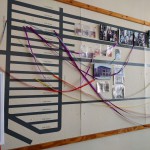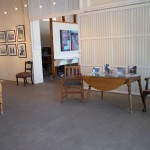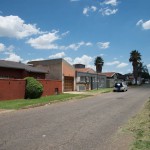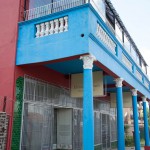By Vishakha Darbha
Salma Patel walked through the two spacious rooms in her museum in Johannesburg, pointing to the black and white pictures lining the creamy walls. Each framed photo depicted moments from a bygone period, illuminating the story of a multi-racial community and its Indian bazaar that fought against eviction on racial grounds.
Patel is the curator of Fietas Museum, created as an ode to the historic 14th street of Johannesburg. Once bustling with traders and families chatting on verandahs while sipping their evening tea, today the area is defined by the brick skeletons of abandoned homes on land left overgrown and fallow. Patel’s museum, also her residence since 1987, rises from the decrepit landscape. It is a brightly colored building, designed in the style of Malaysian houses from the 19th Century.
“My mother and father got married in this house. My surrogate grandmother’s son was one of the first Indians to resist forced removals in this area,” said Patel when describing what made the house stand out among the rest in Fietas. “We fought to keep this house, but 20 years into our democracy, the land still remains empty.”
During Apartheid South Africa, The Group Areas Act of the 1950s assigned racial groups to different residential and business sections. The act led to the breakdown of areas like Fietas.
Fietas is marked by De La Ray Street, beyond which was the exclusive white community, and Krause Street. In between the two was a vibrant community that stretched from 11th to 26th street. The pictures in the museum painted a colorful landscape of traders who lined up outside their houses to sell their wares.
“My brother and I would walk up and down this street, selling combs. That’s how we earned our pocket money,” said Patel. “That was the culture of Fietas, and the government took it all away with the stroke of a pen.”
From a highly diverse neighborhood, Fietas morphed into one that gradually lost its roots as well as its people.
Patel’s museum contains some photographs by David Goldblatt, a South African photographer known for his arresting photos of the country during apartheid. The museum also consists of an interactive wall where visitors, particularly those from the area, can leave their mark by placing old images and postcards across the wall. As an activist for social justice issues, Patel saw no better opportunity than to convert her home, Number 25 14th Street, into a monument that celebrated the social and political hub it used to be.
“For me, my whole life has been shaped around the fact that we didn’t have a home,” said Patel. “I grew up in a culture of social justice movements, peoples’ tenacity and absolute acts of defiance.”
By the mid-1970s, most people were forced to settle in townships designed for particular racial groups. One such township was Lenasia, a community that was predominantly Indian.
While describing the old days, Indian-South African filmmaker and writer Feizel Mamdoo said that there was always a longing to return to the strong community bonds that were created in cosmopolitan areas like Fietas.
“We had a larger house in Lenasia. I could now fly my kite in the open with little risk of it getting caught up in telephone wires,” he said. His family was one of the first to leave Fietas. “My emotional and spiritual realization of Fietas only came after 1976, when I saw the value and the need in remaking the country.”
For the Indians residing in South Africa, they drew some political inspiration from Gandhi, whose non-violent protest against the British rule in India stemmed in part from the racial struggles he had witnessed in South Africa before he returned to Indian in 1915. But 20 years after the constitution, things are gradually beginning to change.
“The Indian identity has merged into the South African psyche, and a lot of it was due to areas like Fietas,” said Mamdoo. “But with the townships, people still associate with their old identities, halting proper integration even so many years later.”
This was echoed by Patel, who identifies as both South African and Indian.
“I am resentful when somebody assumes I am not South African. But at the same time, I am very Indian,” said Patel, who spoke about how she embraced her South African identity while growing up around Chinese, Malays, and Africans in Fietas. “I enjoy and relate aspects of western culture, of African culture, part of what makes me South African. To pigeonhole me would not be right.”
As Patel concluded the tour of her museum, she pointed to the red pillars holding up the building’s bright blue exterior. “This building is where generations of families lived and traded. To bring it down would be a massive disservice.”
She added, “If you just take the drive up the road, you will see the homeless occupying the fallow land. You can then understand where we come from when we fought for this house, and 22 years later, why I cannot leave.”










